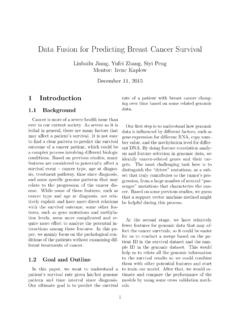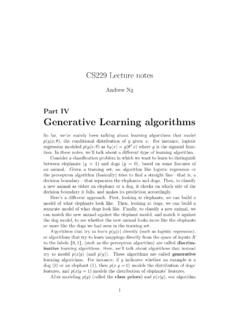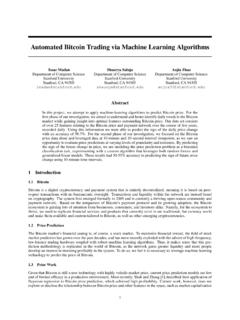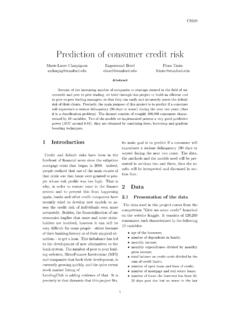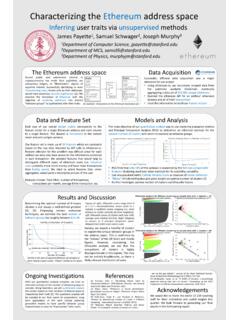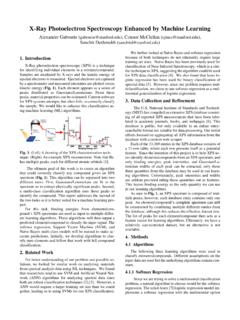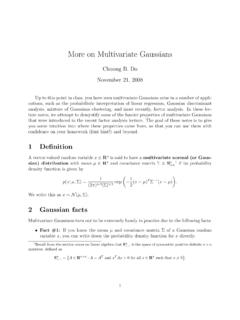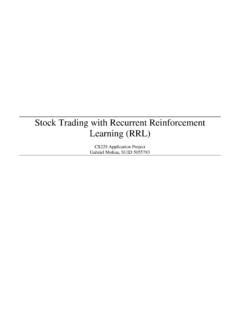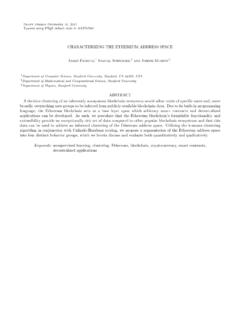Transcription of Time Series Sales Forecasting - Stanford University
1 1 time Series Sales Forecasting James J. Pao*, Danielle S. Sullivan** Abstract The ability to accurately forecast data is highly desirable in a wide variety of fields such as Sales , stocks, sports performance, and natural phenomena. Presented here is a study of several time Series Forecasting methods applied to retail Sales data, comprising weekly Sales figures from various Walmart department stores across the United States over a period of approximately 2 and a half years. Significant surges in Sales are noticeable in the data during pre-holiday and holiday weeks, which present a challenge for any developed Forecasting models.
2 The prediction models implemented herein are regression decision trees, Seasonal-Trend Decomposition using Loess and Autoregressive Integrated Moving-Average (STL + ARIMA) models, and time -lagged feed-forward neural networks (FFNNs). In particular, the STL + ARIMA and the time -lagged FFNN s performed reasonably well in Forecasting the weekly Sales data. The best FFNN implementation, using a time -lag value d = 4 and mean weekly Sales as inputs, achieved a mean absolute error of 1252. Weekly Sales for the store departments are in the tens of thousands.
3 It is also notable that the results achieved by the time -lagged FFNN s did not require any deseasonalizing of the Sales data, indicating that neural networks may be able to effectively detect and consider any seasonality during training and prediction. 1 INTRODUCTIONN a world today where competitive margins are becoming increasingly narrower and actions must be decisive yet informed, the ability to accu-rately make forecasts is of premier importance. This is certainly true in the Forecasting of numeri-cal data such as the health of a country s economy or the movements of a stock market from day to day.
4 Forecasting is even beneficial in domains such as environmental monitoring or sports perfor-mance, and, accordingly, much Forecasting work has been done across a broad swath of exciting fields and disciplines. A more traditional yet still thoroughly compel-ling application of Forecasting is Sales prediction, which is the focus of this work. As markets become more and more global and competition is ruthless, optimizing an organization s operational effi-ciency is of premium importance.
5 When compa-nies must spread their resources broadly and con-sumers have a surfeit of choices, every advantage a company can squeeze out will make a difference. If a company can match the demand of a product with just the right amount of supply, then there will be no lost Sales due to a lack of inventoy as well as no costs from overstocking. Sales forecast-ing uses patterns gleaned from historical data to predict future Sales , allowing for informed courses-of-action such as allocating or diverting existing inventory, or increasing or decreasing fu-ture production.
6 This work investigates the performance of a va-riety of predictive models for the application of de-partmental Sales Forecasting . As a baseline method, a regression decision tree is implemented. Then, the more sophisticated models of Seasonal-Tre n d Decomposition using Loess and Autoregressive Integrated Moving-Av e r a g e ( S T L + A R I M A ) and feed-forward neural networks using time -lagged inputs were used. 2 RELATED WORK Two currently popular approaches to nonlinear time Series prediction problems are statistical ap-proaches using ARIMA and machine learning ap-proaches using artificial neural Networks (ANNs).
7 ANNs have shown to perform well in time Series Forecasting because of their ability to accurately represent non-linear data [1]. Both of these approaches have had success when applied to Sales Forecasting and stock predictions [2]. When applied to financial data, the ARIMA model is able to leverage the fact that financial time Series data is generally related to past values [3]. Provided there are no sudden changes in value or behavior, an ARIMA model will also be very effec-tive for financial time Series Forecasting [4].
8 In his 2010 paper Adebiyi [4] applies the ARIMA model to accurately forecast the Nokia stock prices. It is important to note that the linear assump-tions of the ARIMA model have resulted in poor Forecasting models in cases of stock price predic-tion when the dataset includes values coming into and coming out of an economic recession (chang-ing properties). I 2 In a separate paper Adebiyi [2] implements an ANN model and an ARIMA model to to predict Dell stock prices.
9 In his model comparison, the ANN slightly outperforms the ARIMA model. Adebiyi attributes this partially to the fact that the ARIMA model assumes that the times Series is generated from a linear process. 3 DATASET The dataset used was provided by Walmart Inc., an American multinational retail corporation, for a 2014 data science competition (Kaggle). The dataset contains historical weekly Sales data from 45 Walmart department stores in different re-gions across the United States.
10 The training set has 421,570 samples. Each sample has the following features: departmental weekly Sales , the associated department (81 departments, each listed as a num-ber), the associated store (listed as a number), the store type, the date of the week s start day, a flag indicating if the week contains a major holiday (Super Bowl, Labor Day, Thanksgiving, Christ-mas). Also supplied is a corresponding set of features for each week-store combination which includes temperature, fuel price, CPI, unemployment rate, and promotional markdown data.

